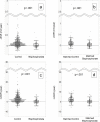Bisphosphonate use is associated with a decreased joint narrowing rate in the non-arthritic hip
- PMID: 36384277
- PMCID: PMC9680202
- DOI: 10.1302/2046-3758.1111.BJR-2022-0155.R1
Bisphosphonate use is associated with a decreased joint narrowing rate in the non-arthritic hip
Abstract
Aims: The preventive effects of bisphosphonates on articular cartilage in non-arthritic joints are unclear. This study aimed to investigate the effects of oral bisphosphonates on the rate of joint space narrowing in the non-arthritic hip.
Methods: We retrospectively reviewed standing whole-leg radiographs from patients who underwent knee arthroplasties from 2012 to 2020 at our institute. Patients with previous hip surgery, Kellgren-Lawrence grade ≥ II hip osteoarthritis, hip dysplasia, or rheumatoid arthritis were excluded. The rate of hip joint space narrowing was measured in 398 patients (796 hips), and the effects of the use of bisphosphonates were examined using the multivariate regression model and the propensity score matching (1:2) model.
Results: A total of 45 of 398 (11.3%) eligible patients were taking an oral bisphosphonate at the time of knee surgery, with a mean age of 75.8 years (SD 6.2) in bisphosphonate users and 75.7 years (SD 6.8) in non-users. The mean joint space narrowing rate was 0.04 mm/year (SD 0.11) in bisphosphonate users and 0.12 mm/year (SD 0.25) in non-users (p < 0.001). In the multivariate model, age (standardized coefficient = 0.0867, p = 0.016) and the use of a bisphosphonate (standardized coefficient = -0.182, p < 0.001) were associated with the joint space narrowing rate. After successfully matching 43 bisphosphonate users and 86 non-users, the joint narrowing rate was smaller in bisphosphonate users (p < 0.001).
Conclusion: The use of bisphosphonates is associated with decreased joint degeneration in non-arthritic hips after knee arthroplasty. Bisphosphonates slow joint degeneration, thus maintaining the thickness of joint cartilage in the normal joint or during the early phase of osteoarthritis.Cite this article: Bone Joint Res 2022;11(11):826-834.
Keywords: Bisphosphonate; Hip osteoarthritis; Joint cartilage; Joint space narrowing; Knee arthroplasty; Osteoarthritis (OA); Osteoporosis; arthritis hips; bisphosphonates; hips; joint degeneration; joint space narrowing; knee arthroplasties; propensity score matching; radiographs; rheumatoid arthritis.
Figures




Similar articles
-
Association between acetabular coverage over femoral head and rate of joint space narrowing in non-arthritic hips.Bone Jt Open. 2025 Jan 15;6(1):93-102. doi: 10.1302/2633-1462.61.BJO-2024-0143.R1. Bone Jt Open. 2025. PMID: 39809301 Free PMC article.
-
Number of Levels of Spinal Fusion Associated with the Rate of Joint-Space Narrowing in the Hip.J Bone Joint Surg Am. 2021 Jun 2;103(11):953-960. doi: 10.2106/JBJS.20.01578. J Bone Joint Surg Am. 2021. PMID: 33770019
-
Validation of joint space narrowing on plain radiographs and its relevance to partial knee arthroplasty.Bone Joint Res. 2021 Mar;10(3):173-187. doi: 10.1302/2046-3758.103.BJR-2020-0216.R1. Bone Joint Res. 2021. PMID: 33685206 Free PMC article.
-
Total joint replacement of hip or knee as an outcome measure for structure modifying trials in osteoarthritis.Osteoarthritis Cartilage. 2005 Jan;13(1):13-9. doi: 10.1016/j.joca.2004.10.012. Osteoarthritis Cartilage. 2005. PMID: 15639632 Review.
-
Arthritis Foundation/HSS Workshop on Hip Osteoarthritis, Part 2: Detecting Hips at Risk: Early Biomechanical and Structural Mechanisms.HSS J. 2023 Nov;19(4):428-433. doi: 10.1177/15563316231192097. Epub 2023 Aug 30. HSS J. 2023. PMID: 37937085 Free PMC article. Review.
Cited by
-
Effect of Osteoporosis Treatments on Osteoarthritis Progression in Postmenopausal Women: A Review of the Literature.Curr Rheumatol Rep. 2024 May;26(5):188-195. doi: 10.1007/s11926-024-01139-8. Epub 2024 Feb 19. Curr Rheumatol Rep. 2024. PMID: 38372871 Free PMC article. Review.
-
Association between acetabular coverage over femoral head and rate of joint space narrowing in non-arthritic hips.Bone Jt Open. 2025 Jan 15;6(1):93-102. doi: 10.1302/2633-1462.61.BJO-2024-0143.R1. Bone Jt Open. 2025. PMID: 39809301 Free PMC article.
-
The role of cells and signal pathways in subchondral bone in osteoarthritis.Bone Joint Res. 2023 Sep 8;12(9):536-545. doi: 10.1302/2046-3758.129.BJR-2023-0081.R1. Bone Joint Res. 2023. PMID: 37678837 Free PMC article.
References
-
- He Z, Nie P, Lu J, et al. . Less mechanical loading attenuates osteoarthritis by reducing cartilage degeneration, subchondral bone remodelling, secondary inflammation, and activation of NLRP3 inflammasome. Bone Joint Res. 2020;9(10):731–741. 10.1302/2046-3758.910.BJR-2019-0368.R2 - DOI - PMC - PubMed

